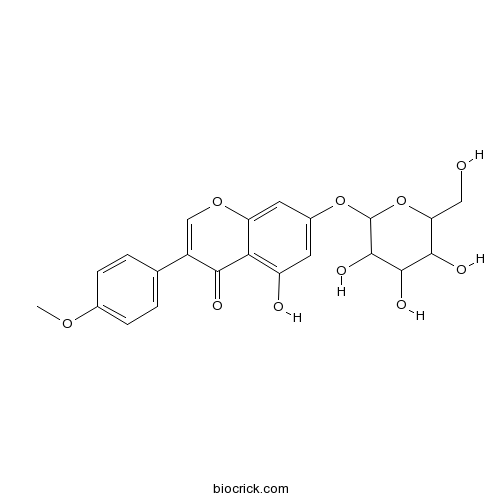SissotrinCAS# 5928-26-7 |

Quality Control & MSDS
3D structure
Package In Stock
Number of papers citing our products

| Cas No. | 5928-26-7 | SDF | Download SDF |
| PubChem ID | 5358913 | Appearance | Yellow powder |
| Formula | C22H22O10 | M.Wt | 446.4 |
| Type of Compound | Flavonoids | Storage | Desiccate at -20°C |
| Solubility | Soluble in Chloroform,Dichloromethane,Ethyl Acetate,DMSO,Acetone,etc. | ||
| Chemical Name | 5-hydroxy-3-(4-methoxyphenyl)-7-[3,4,5-trihydroxy-6-(hydroxymethyl)oxan-2-yl]oxychromen-4-one | ||
| SMILES | COC1=CC=C(C=C1)C2=COC3=CC(=CC(=C3C2=O)O)OC4C(C(C(C(O4)CO)O)O)O | ||
| Standard InChIKey | LFEUICHQZGNOHD-UHFFFAOYSA-N | ||
| Standard InChI | InChI=1S/C22H22O10/c1-29-11-4-2-10(3-5-11)13-9-30-15-7-12(6-14(24)17(15)18(13)25)31-22-21(28)20(27)19(26)16(8-23)32-22/h2-7,9,16,19-24,26-28H,8H2,1H3 | ||
| General tips | For obtaining a higher solubility , please warm the tube at 37 ℃ and shake it in the ultrasonic bath for a while.Stock solution can be stored below -20℃ for several months. We recommend that you prepare and use the solution on the same day. However, if the test schedule requires, the stock solutions can be prepared in advance, and the stock solution must be sealed and stored below -20℃. In general, the stock solution can be kept for several months. Before use, we recommend that you leave the vial at room temperature for at least an hour before opening it. |
||
| About Packaging | 1. The packaging of the product may be reversed during transportation, cause the high purity compounds to adhere to the neck or cap of the vial.Take the vail out of its packaging and shake gently until the compounds fall to the bottom of the vial. 2. For liquid products, please centrifuge at 500xg to gather the liquid to the bottom of the vial. 3. Try to avoid loss or contamination during the experiment. |
||
| Shipping Condition | Packaging according to customer requirements(5mg, 10mg, 20mg and more). Ship via FedEx, DHL, UPS, EMS or other couriers with RT, or blue ice upon request. | ||
| Description | 1. Sissotrin can impair glucose tolerance. |

Sissotrin Dilution Calculator

Sissotrin Molarity Calculator
| 1 mg | 5 mg | 10 mg | 20 mg | 25 mg | |
| 1 mM | 2.2401 mL | 11.2007 mL | 22.4014 mL | 44.8029 mL | 56.0036 mL |
| 5 mM | 0.448 mL | 2.2401 mL | 4.4803 mL | 8.9606 mL | 11.2007 mL |
| 10 mM | 0.224 mL | 1.1201 mL | 2.2401 mL | 4.4803 mL | 5.6004 mL |
| 50 mM | 0.0448 mL | 0.224 mL | 0.448 mL | 0.8961 mL | 1.1201 mL |
| 100 mM | 0.0224 mL | 0.112 mL | 0.224 mL | 0.448 mL | 0.56 mL |
| * Note: If you are in the process of experiment, it's necessary to make the dilution ratios of the samples. The dilution data above is only for reference. Normally, it's can get a better solubility within lower of Concentrations. | |||||

Calcutta University

University of Minnesota

University of Maryland School of Medicine

University of Illinois at Chicago

The Ohio State University

University of Zurich

Harvard University

Colorado State University

Auburn University

Yale University

Worcester Polytechnic Institute

Washington State University

Stanford University

University of Leipzig

Universidade da Beira Interior

The Institute of Cancer Research

Heidelberg University

University of Amsterdam

University of Auckland

TsingHua University

The University of Michigan

Miami University

DRURY University

Jilin University

Fudan University

Wuhan University

Sun Yat-sen University

Universite de Paris

Deemed University

Auckland University

The University of Tokyo

Korea University
- Decursin
Catalog No.:BCN5335
CAS No.:5928-25-6
- Acyclovir
Catalog No.:BCC3929
CAS No.:59277-89-3
- Meptazinol HCl
Catalog No.:BCC4920
CAS No.:59263-76-2
- Rigosertib sodium
Catalog No.:BCC4067
CAS No.:592542-60-4
- Rigosertib
Catalog No.:BCC4296
CAS No.:592542-59-1
- Chikusetsu Saponin Ib
Catalog No.:BCC8308
CAS No.:59252-87-8
- Laurocapram
Catalog No.:BCN8308
CAS No.:59227-89-3
- Erigeroside
Catalog No.:BCC8171
CAS No.:59219-76-0
- Darutoside
Catalog No.:BCN4094
CAS No.:59219-65-7
- 8(14),15-Isopimaradiene-3,18-diol
Catalog No.:BCN4093
CAS No.:59219-64-6
- beta-Dihydroplumericinic acid
Catalog No.:BCN4092
CAS No.:59204-61-4
- Sulforaphene
Catalog No.:BCN8179
CAS No.:592-95-0
- Vitexin 2''-O-p-coumarate
Catalog No.:BCN2793
CAS No.:59282-55-2
- Lindleyin
Catalog No.:BCN8450
CAS No.:59282-56-3
- Triacontanol
Catalog No.:BCC8260
CAS No.:593-50-0
- Alizapride HCl
Catalog No.:BCC4618
CAS No.:59338-87-3
- PIK-93
Catalog No.:BCC2519
CAS No.:593960-11-3
- Darutigenol
Catalog No.:BCN4096
CAS No.:5940-00-1
- Boc-HoSer(Bzl)-OH
Catalog No.:BCC3244
CAS No.:59408-74-1
- 1F-Fructofuranosylnystose
Catalog No.:BCN8287
CAS No.:59432-60-9
- 1-Methyl-2-undecylquinolin-4(1H)-one
Catalog No.:BCN6591
CAS No.:59443-02-6
- Monotropein
Catalog No.:BCN6280
CAS No.:5945-50-6
- Nimbin
Catalog No.:BCN4617
CAS No.:5945-86-8
- Dihydropyrocurzerenone
Catalog No.:BCN8061
CAS No.:59462-26-9
The opposing effects of the flavonoids isoquercitrin and sissotrin, isolated from Pterospartum tridentatum, on oral glucose tolerance in rats.[Pubmed:18338765]
Phytother Res. 2008 Apr;22(4):539-43.
The effect of an aqueous extract of Pterospartum tridentatum on the blood glucose levels of normal Wistar rats was investigated in a situation of oral glucose challenge. The extract at 300 mg/kg showed an antihyperglycaemic effect in the first 30 min after glucose challenge but then the blood glucose levels rose above those of the control group, indicating the presence of compounds with different effects on glucose tolerance. Nine compounds of isoflavone and flavonol skeletons were identified in the extract by HPLC-ESI-MS(n), four of them being identified for the first time in this species. The isoflavone Sissotrin and the flavonol derivative, isoquercitrin, were selected for the oral glucose tolerance test. Isoquercitrin (100 mg/kg) showed time-dependent antihyperglycaemic activity by delaying the post-oral glucose load glycaemic peak at 30 min, as did the sodium-dependent glucose transporter inhibitor phloridzin (100 mg/kg). In contrast, Sissotrin (100 mg/kg) showed an opposite effect, impairing glucose tolerance. In conclusion, these preliminary results indicate that the effect of the extract on blood glucose may be either antihyperglycaemic or hyperglycaemic. Additionally, as far as is known, these are the first in vivo results on the acute antihyperglycaemic potential of isoquercitrin.


